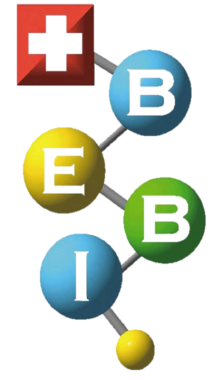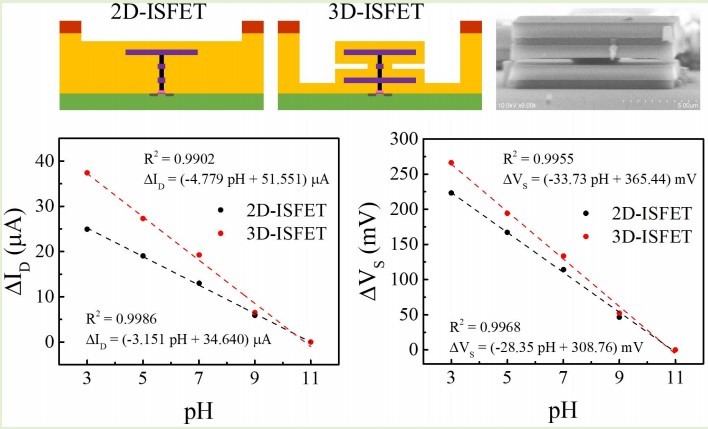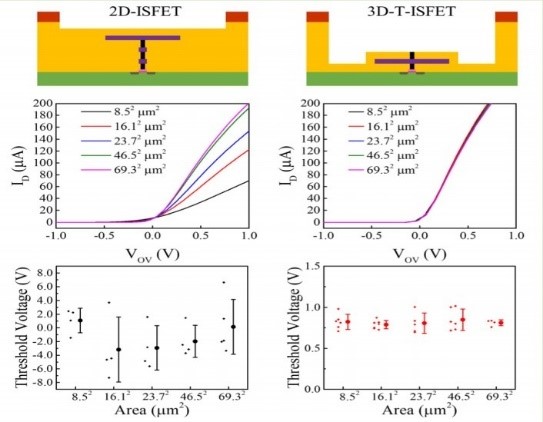研究主題-以3D結構增進傳統ISFET效能
撰寫:學生陳冠彬
ISFETs(Ion-sensitive field-effect transistors,離子敏感場效電晶體)是用於測量溶液當中離子濃度的電晶體,由於其結構相近於MOSFET(金氧半場效電晶體)故可以大量生產在COMS(互補式MOSFET)上以用來作為生物傳感器。在生物醫學的應用之中,ISFET常用來檢測DNA雜交檢測,血液中生物標誌物檢測,抗體檢測,葡萄糖測量和 pH傳感等。
以pH傳感為例,ISFET的工作原理為:由於質子本身可以在電解質當中結合或是游離,這會造成固液接面中的電位差進而形成元件的表面電位,也就是施加電壓,如此一來就可以驅使元件中的電流表現,最後量測電訊號即可換算得到溶液中的pH值為何。
然而傳統的平面ISFET仍有不足之處,當感應區域縮小時元件的敏感度會隨之下降,所以本所所長林致廷老師及其團隊開發出三維閘極結構的ISFET來解決這個問題。在感應區面積微縮下,閘極優化過後的元件確實解決了電流衰減的問題,此外林所長還有設計另一種的三維結構,使得元件在同個pH值下能夠有傳統元件1.5倍的電流增益和1.15倍的電壓增益,成功地加強了元件的敏感度。
這項研究可以更加強現今生物傳感器上的精準度,並且能夠達到儀器微縮的目的,由於解決了電流衰減的問題,這樣就可以在同面積的感測區放上更多的元件,以增加感測的像素。
圖1為改善電流衰減的結構[1]
圖2為提升元件電流、電壓增益的結構[2]
As a sensor, an ion-sensitive field-effect transistor (ISFET) can transduce the environmental information into electrical signals. So it have been applied in DNA sequencing, biomarker detection and pH sensing. Furthermore, ISFET is based on MOSFET device structure thus, it can be manufactured using a CMOS process.
According to the solution pH value, protons can associate or dissociate on the dielectric surface. This causes a charge variation at the solid-liquid interface, which in turn establishes a surface potential variation. This potential variation can affect the transistor current behavior. Therefore, the analyte pH value can be deduced based on the electrical signal variation.
However, CMOS-based ISFETs are still suffering problems of scaling attenuation. To deal with this, team of Pro. Lin developed a novel CMOS ISFET configuration, namely, 3D-T-ISFET. Based on their experiments, on the same footprint, a 3.21-fold ID/pH improvement can be achieved by developed 3D-T-ISFET, and it exhibits a scaling attenuation-free behavior! In addition, Pro. Lin designed another kind of configuration, which called “3D-extended structure”. This device exploits vertical space and more sensing surface area can be obtained in a given footprint area. In the end, 3D-extended structure improves pH sensitivity 1.5-fold in current mode and 1.15-fold in voltage mode.
The improvement of ISFET can enhance the accurate of CMOS device and shrink the detector. The pixels of the CMOS detector will be more meticulous too.
[1] N. Y. Teng and C. T. Lin, “CMOS ISFETs With 3D-Truncated Sensing Structure Resistant to Scaling Attenuation and Trapped Charge-Induced Offset,” IEEE Sensors Journal, vol. 21, no. 24, pp. 27282-27289, 2021, doi: 10.1109/JSEN.2021.3126210. [2] N. Y. Teng, Y. T. Wu, R. X. Wang, and C. T. Lin, “Sensing Characteristic Enhancement of CMOS-Based ISFETs With Three-Dimensional Extended- Gate Architecture,” IEEE Sensors Journal, vol. 21, no. 7, pp. 8831-8838, 2021, doi: 10.1109/JSEN.2021.3052772.


